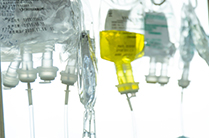Overview
What Is Non-Hodgkins Lymphoma?
Non-Hodgkins lymphoma is a type of cancer in the lymphatic system. Non-Hodgkins lymphoma causes the cells in the lymphatic system to abnormally reproduce, eventually causing tumors to grow. Because lymph tissue is found throughout the body, adult non-Hodgkins lymphoma can begin in almost any part of the body. Cancer can spread to the liver and many other organs and tissues.
Prognosis
People have survived every stage of non-Hodgkins lymphoma. People with non-Hodgkins lymphoma now have more treatment choices and more hope for survival than ever before.
Symptoms
What are possible signs of Non-Hodgkins lymphoma?
The following are the most common symptoms of non-Hodgkins lymphoma. However, each individual may experience symptoms differently. Symptoms may include:
• Painless swelling of lymph nodes in neck, underarm, and/or groin
• Fever for no known reason
• Drenching night sweats
• Feeling very tired
• Weight loss for no known reason
• Skin rash or itchy skin
• Recurring infections
• Swelling or pain in the chest, abdomen, or bones for no known reason
• Swelling in the face and arms
The symptoms of non-Hodgkins lymphoma may resemble other blood disorders or medical problems, such as influenza or other infections. In fact, many of these symptoms are more likely to be caused by something other than lymphoma. Always consult your doctor for a diagnosis.
Causes
Risk Factors of Non-Hodgkins Lymphoma
Having a risk factor does not mean that you will get cancer; not having risk factors doesn't mean that you will not get cancer. Some risk factors are out of your control, such as age or gender. However, you do have control over some risk factors, such as exposure to certain infections. People who think they may be at risk should discuss this with their doctor.
Risk factors for non-Hodgkins lymphoma include the following:
• Older age
• Male gender
• Immune system deficiency
• Autoimmune diseases
• Exposure to radiation
• Exposure to chemicals such as benzene and herbicides
• Infections with human immunodeficiency virus (HIV), hepatitis C virus, or human T-cell leukemia/lymphoma virus (HTLV-1)
• History of infectious mononucleosis (caused by an infection with the Epstein-Barr virus)
• Infection with Helicobacter pylori (H. pylori) bacterium, which has been identified as a cause of stomach ulcers
• Past treatment for Hodgkins lymphoma
Types
Types of Non-Hodgkin's Lymphomas
There are many types of non-Hodgkins lymphomas. Some types spread more quickly than others. The type is determined by how the cancer cells look under a microscope. This determination is called the histology. The histologies for adult non-Hodgkins lymphoma are divided into 2 groups:
• Indolent lymphomas, which are slower growing and have fewer symptoms
• Aggressive lymphomas, which grow more quickly
Aggressive lymphomas are also seen more frequently in patients who are HIV-positive (AIDS-related lymphoma).
Diagnosis
How is Non-Hodgkins lymphoma identified?
Tests that examine the body and lymph system are used to help detect (find) and diagnose adult non-Hodgkins lymphoma.
The following tests and procedures may be used:
Physical exam and history is an exam of the body to check general signs of health, including checking for signs of disease, such as lumps or anything else that seems unusual. A history of the patient's health habits and past illnesses and treatments will also be taken.
Please provide your medical records to us before your appointment. At the visit itself, the nurses and doctors will ask additional questions and carry out a detailed physical exam.
Bone marrow aspiration and biopsy involves the removal of bone marrow, blood, and a small piece of bone by inserting a needle into the hipbone or breastbone. This type of biopsy is performed either from the sternum (breastbone) or the iliac crest hipbone (the bone area on either side of the pelvis on the lower back area). The skin is cleansed and a local anesthetic is given to numb the area. A long, rigid needle is inserted into the marrow, and cells are aspirated for study; this step is occasionally uncomfortable. A pathologist views the bone marrow, blood, and bone under a microscope to look for signs of cancer. A core biopsy (removing a small bone 'chip' from the marrow) may follow the aspiration.
A lumbar puncture (also called a spinal tap) can be used to analyze the fluid in the spinal cord. This test is helpful for spinal tumor assessment and also for measuring whether certain cancers have spread to the brain. In this procedure, a special needle is inserted into the lower back spinal canal. This is the area around the spinal cord. The pressure in the spinal canal and brain can then be measured. A small amount of cerebral spinal fluid (CSF), the fluid in the brain and spinal cord, can be removed and sent for testing to determine if there is an infection or other problems.
A lymph node biopsy is the removal of all or part of a lymph node. A pathologist views the tissue under a microscope to look for cancer cells. During an excisional biopsy, an entire lymph node will be taken out whereas only a part of a lymph node will be removed during an incisional biopsy.
Laparoscopy is a surgical procedure to look at the organs inside the abdomen to check for signs of disease. Small incisions (cuts) are made in the wall of the abdomen and a laparoscope (a thin, lighted tube) is inserted into one of the incisions. Other instruments may be inserted through the same or other incisions to perform procedures such as removing organs or taking tissue samples to be checked under a microscope for signs of disease.
A surgical procedure in which an incision (cut) is made in the wall of the abdomen to check the inside of the abdomen for signs of disease. The size of the incision depends on the reason the laparotomy is being done. Sometimes organs are removed or tissue samples are taken and checked under a microscope for signs of disease.
If cancer is found, the following tests may be done to study the cancer cells:
An immunocytochemistry study is a laboratory test in which a substance such as an antibody, dye, or radioisotope is added to a sample of cancer cells to test for certain antigens. This type of study is used to tell the difference between different types of cancer.
In this laboratory test, cells in a sample of blood or bone marrow are viewed under a microscope to look for certain changes in the structure or number of chromosomes in the lymphocytes.
Immunophenotyping is a test in which the cells in a sample of blood or bone marrow are looked at under a microscope to find out if malignant lymphocytes (cancer) began from the B lymphocytes or the T lymphocytes. The process identifies cells based on the types of antigens or markers on the surface of the cell. This process is used to diagnose specific types of leukemia and lymphoma by comparing the cancer cells to normal cells of the immune system.
Tests and procedures that may be used in the staging process for Non-Hodgkins lymphoma
The following tests and procedures may be used in the staging process for non-Hodgkins lymphoma:
A complete blood count (CBC) measures the size, number, and maturity of the different blood cells in a specific volume of blood. This is one of the most common tests performed.
• Red blood cells are important for carrying oxygen and fighting anemia and fatigue. The hemoglobin portion of the CBC measures the oxygen carrying capacity of the red blood cells while the hematocrit measures the percentage of red blood cells in the blood.
• White blood cells fight infection. Increased numbers of white blood cells, therefore, may indicate the presence of an infection. Decreased levels may indicate certain rheumatic diseases or reaction to medication.
• Platelets prevent the body from bleeding and bruising easily. It is usually performed to check for a blood infection.
A blood chemistry study is a procedure in which a blood sample is checked to measure the amounts of certain substances released into the blood by organs and tissues in the body. An unusual (higher or lower than normal) amount of a substance can be a sign of disease in the organ or tissue that makes it.
Computed tomography scan (CT or CAT scan) is a non-invasive diagnostic imaging procedure that uses a combination of special X-ray equipment and sophisticated computer technology to produce cross-sectional images (often called slices), both horizontally and vertically, of the body. These cross-sectional images of the area being studied can then be examined on a computer monitor or printed.
CT scans are more detailed than general X-rays, showing detailed images of any part of the body, including the bones, muscles, fat, and organs. CT scans of internal organs, bone, soft tissue and blood vessels provide greater clarity and reveal more details than regular X-ray exams. CT scans also minimize exposure to radiation. A dye may be injected into a vein or swallowed to help the organs or tissues show up more clearly.
In standard X-rays, a beam of energy is aimed at the body part being studied. A plate behind the body part captures the variations of the energy beam after it passes through skin, bone, muscle, and other tissue. While much information can be obtained from a standard X-ray, a lot of detail about internal organs and other structures is not available.
In computed tomography, the X-ray beam moves in a circle around the body. This allows many different views of the same organ or structure. The X-ray information is sent to a computer that interprets the X-ray data and displays it in a two-dimensional (2D) form on a monitor.
Using specialized equipment and expertise to create and interpret CT scans of the body, radiologists can more easily diagnose problems such as cancers, cardiovascular disease, infectious disease, trauma and musculoskeletal disorders.
CT scans of the chest can provide more detailed information about organs and structures inside the chest than standard X-rays of the chest, thus providing more information related to injuries and/or diseases of the chest (thoracic) organs.
Chest CT scans may also be used to visualize placement of needles during biopsies of thoracic organs or tumors, or during aspiration (withdrawal) of fluid from the chest. This is useful in monitoring tumors and other conditions of the chest before and after treatment.
CT scans may be done with or without "contrast." Contrast refers to a substance taken by mouth or injected into an intravenous (IV) line that causes the particular organ or tissue under study to be seen more clearly. Contrast examinations may require you to fast for a certain period of time before the procedure. Your physician will notify you of this prior to the procedure.
Care agreement:
You have the right to help plan your care. To help with this plan, you must learn about your health condition and how it may be treated. You can then discuss treatment options with your caregivers. Work with them to decide what care may be used to treat you. You always have the right to refuse treatment.
Related procedures
Other related procedures that may be used to assess the heart include:
• Resting or exercise electrocardiogram (ECG or EKG)
• Holter monitor
• Signal-averaged ECG
• Cardiac catheterization
• Chest X-ray
• Echocardiogram
• Electrophysiological studies
• Magnetic resonance imaging (MRI) of the heart
• Myocardial perfusion scans
• Radionuclide angiography
• Ultrafast CT scan
Positron emission tomography, also called PET imaging or a PET scan, is a type of nuclear medicine imaging. A PET scan measures important body functions, such as blood flow, oxygen use, and sugar (glucose) metabolism, to help doctors evaluate how well organs and tissues are functioning.
PET is a powerful diagnostic test that is having a major impact on the diagnosis and treatment of disease. A PET scan (positron emission tomography scan) monitors the biochemical functioning of cells by detecting how they process certain compounds, such as glucose (sugar). PET can detect extremely small cancerous tumors, subtle changes of the brain and heart, and give doctors important early information about heart disease and many neurological disorders, like Alzheimer's.
Most common medical tests, like CT and MRI scans, only show details about the structure of your body. PET scans give doctors images of function throughout the entire body, uncovering abnormalities that might otherwise go undetected. This allows doctors to treat these diseases earlier and more accurately. A PET scan puts time on your side. The earlier the diagnosis, the better the chance for treatment.
For example, a PET scan is the most accurate, non-invasive way to tell whether or not a tumor is benign or malignant, sparing patients expensive, often painful diagnostic surgeries and suggesting treatment options earlier in the course of the disease. Although cancer spreads silently in the body, PET can inspect all organs of the body for cancer in a single examination.
Today, most PET scans are performed on instruments that are combined PET and CT scanners. The combined PET/CT scans provide images that pinpoint the location of abnormal metabolic activity within the body. The combined scans have been shown to provide more accurate diagnoses than the two scans performed separately.
About nuclear medicine
Nuclear medicine is a branch of medical imaging that uses small amounts of radioactive material to diagnose or treat a variety of diseases, including many types of cancers, heart disease, and certain other abnormalities within the body. Depending on the type of nuclear medicine exam you are undergoing, the radiotracer is either injected into a vein, swallowed or inhaled as a gas and eventually accumulates in the organ or area of your body being examined, where it gives off energy in the form of gamma rays. This energy is detected by a device called a gamma camera, a PET scanner and/or probe.
A magnetic resonance (REZ-oh-nans) imaging scan is usually called an MRI. An MRI does not use radiation (X-rays) and is a noninvasive medical test or examination. The MRI machine uses a large magnet and a computer to take pictures of the inside of your body. Each picture or "slice" shows only a few layers of body tissue at a time. The pictures can then be examined on a computer monitor.
Pictures taken this way may help caregivers find and see problems in your body more easily. The scan usually takes between 15 to 90 minutes. Including the scan, the total examination time usually takes between 1.5 to 3 hours.
A substance called gadolinium is injected into a vein to help the physicians see the image more clearly. The gadolinium collects around cancer cells so they show up brighter in the picture. Sometimes a procedure called magnetic resonance spectroscopy (MRS) is done during the MRI scan. An MRS is used to diagnose tumors based on their chemical make-up.
How does MRI work?
The MRI machine is a large, cylindrical (tube-shaped) machine that creates a strong magnetic field around the patient. This magnetic field, along with a radiofrequency, alters the hydrogen atoms' natural alignment in the body.
A magnetic field is created and pulses of radio waves are sent from a scanner. The radio waves knock the nuclei of the atoms in the body out of their normal position; as the nuclei realign back into proper position, they send out radio signals.
These signals are received by a computer that analyzes and converts them into an image of the part of the body being examined. This image appears on a viewing monitor. Some MRI machines look like narrow tunnels, while others are more open.
MRI may be used instead of a CT scan in situations where organs or soft tissue are being studied, because with MRI scanning bones do not obscure the images of organs and soft tissues, as does CT scanning.
Other related procedures that are used to assess the heart may include:
• Resting or exercise electrocardiogram (ECG)
• Signal-averaged electrocardiogram (ECG)
• Holter monitor
• Cardiac catheterization
• Chest X-ray
• Computed tomography (CT scan) of the chest
• Electrophysiological studies
• Myocardial perfusion scans
• Radionuclide angiography
• Ultrafast CT scans
Bone marrow aspiration and biopsy involves the removal of bone marrow, blood, and a small piece of bone by inserting a needle into the hipbone or breastbone. This type of biopsy is performed either from the sternum (breastbone) or the iliac crest hipbone (the bone area on either side of the pelvis on the lower back area). The skin is cleansed and a local anesthetic is given to numb the area. A long, rigid needle is inserted into the marrow, and cells are aspirated for study; this step is occasionally uncomfortable. A pathologist views the bone marrow, blood, and bone under a microscope to look for signs of cancer. A core biopsy (removing a small bone 'chip' from the marrow) may follow the aspiration.
Treatments
Treatment Options for Non-Hodgkins Lymphoma
Non-Hodgkins lymphoma can be treated. Treatment may control or cure the lymphoma. It can also improve your quality of life by controlling symptoms of the disease.
The goal of non-Hodgkins lymphoma treatment is to do one or more of these things.
• Kill the lymphoma cells as quickly as possible
• Stop the growth of new lymphoma cells
• Treat side effects of the lymphoma, such as pain, fevers, chills and night sweats
• Maintain a sense of control over your treatment choices and life
When a patient's Hodgkin's lymphoma does not respond to primary treatment or returns, a stem cell transplant is recommended.
Bone Marrow Transplantation is the way to supply and replace extremely reduced and damaged hematopoietic stem cell. For more information about bone marrow transplantation please click here.
Patients with B cell Hodgkin's lymphoma may choose CAR-T Clinical Trial. This is a Phase I/II study designed to evaluate the safety and efficacy of chimeric antigen receptor T cell immunotherapy (CAR-T) in the treatment of CD19+, CD22+ and BCMA+ B cell lymphoma. For more information about CAR-T Clinical Trial, please click here.
(The content above extract from stanfordhealthcare.org)
-
-
Diseases ·
-














 京公网安备13108202000843号
京公网安备13108202000843号